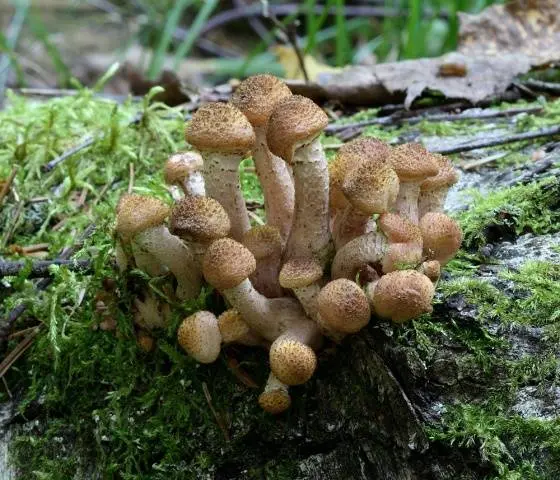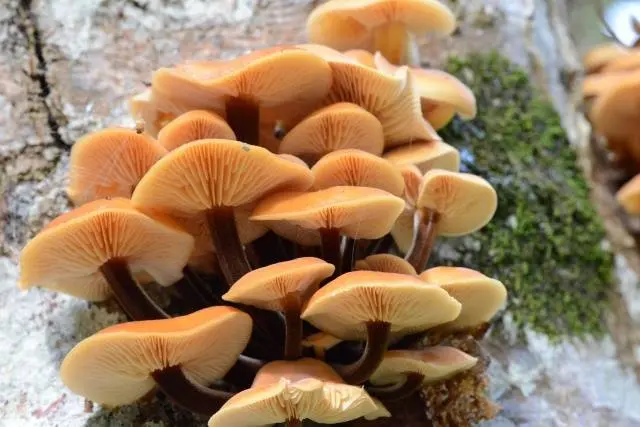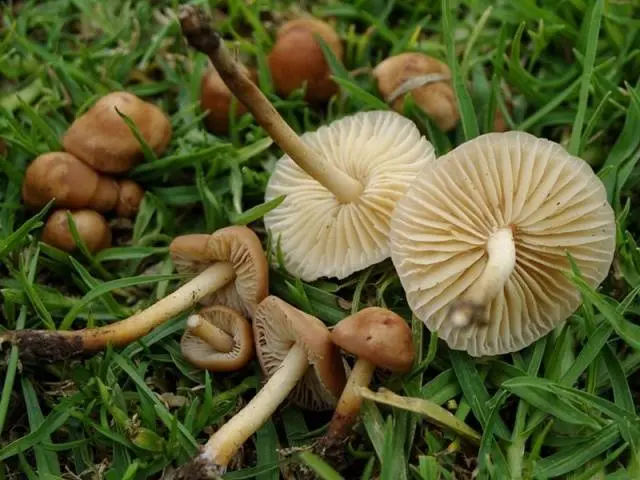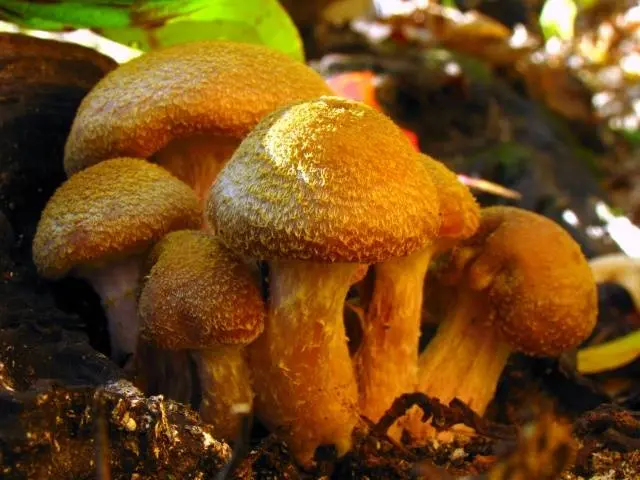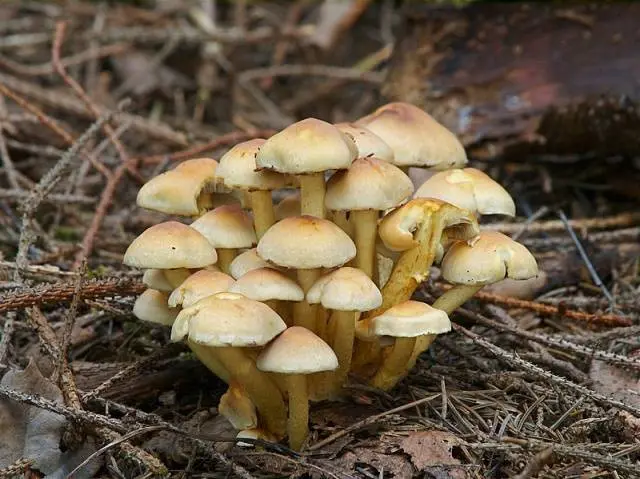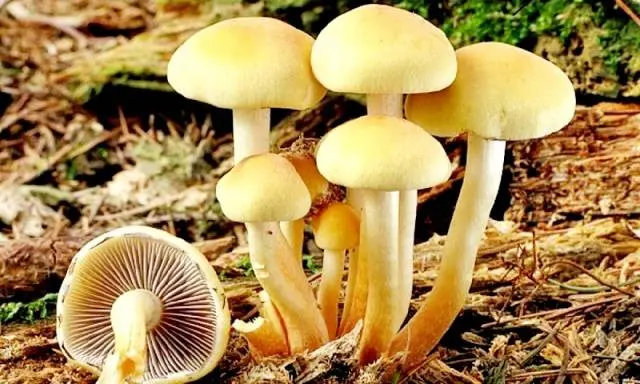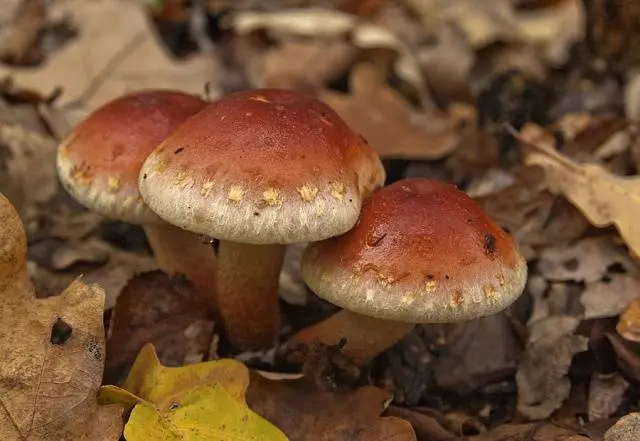Contents
Honey agaric summer is a common mushroom, which is valued for its good taste and beneficial properties. He has dangerous false twins, so it is important to know their distinguishing features.
Summer mushrooms, their description and photo
Mushroom summer mushroom is an edible representative of the Strophariaceae family. It grows in dense groups on dead wood. There are several varieties of this mushroom, which differ in appearance.
Varieties again
The main varieties of mushrooms:
- Summer. Grows in colonies on damaged wood. Known under the names of honey agaric linden, kyuneromyces changeable and talker. It has a good taste, is grown on an industrial scale.

- Autumn (real). An edible mushroom that grows on stumps, fallen and live trees. The height of the stem is 8-10 cm, the diameter is up to 2 cm. The hat is 3-15 cm in size, convex in shape, gradually becomes flattened. There is a pronounced white ring on the stem. The flesh is white, firm and aromatic. Fruiting occurs in layers, each lasts 2-3 weeks.

- Winter. An edible mushroom that parasitizes on dead wood, more often on willow and poplar. The leg is 2-7 cm high, the hat is 2-10 cm in size. It does not have a “skirt” on the leg, which is characteristic of most mushrooms. Grows from autumn to spring in the forest park strip.

- Lugovoi. Prefers forest clearings, meadows, ravines, roadsides. It is distinguished by a convex hat and a thin stem up to 10 cm long. It grows from May to October.

- Thick-legged. It occurs in fallen leaves, on fallen spruce, beech, fir and ash. It has a low straight leg, thickened near the base. The cap size is from 2,5 to 10 cm. In young specimens, it has the shape of an expanded cone with frequent plates.

What do summer mushrooms look like
Description of summer honey agaric:
- the convex shape of the cap in young mushrooms, as it grows, becomes flat with a wide tubercle in the central part;
- cap diameter 3-6 cm;
- in dry weather, it has a matte yellow-brown color;
- at high humidity, the hat becomes brown;
- beards are located along the edges, the skin is smooth and covered with mucus;
- the hymenophore of the summer honey agaric is lamellar, light or dark in color;
- leg height – up to 7 cm, diameter – 0,5 cm;
- its consistency is dense, the color is light on top and dark on the bottom;
- in young mushrooms, the remains of a bedspread in the form of a thin ring are visible;
- the flesh of the cap is thin and watery, in the stem the flesh is darker and denser.
In the photo you can see what summer mushrooms look like:
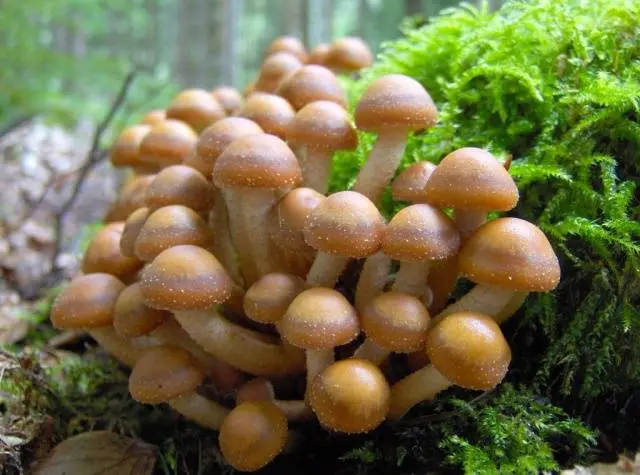
Are summer mushrooms edible
Honey mushrooms are edible, but they are eaten only after heat treatment. First, they are soaked for half an hour, dirt, damaged areas are removed and they are cut into pieces. Be sure to throw away wormy specimens.
For primary processing, fruiting bodies are placed in boiling water. The minimum cooking time is 20 minutes.
The composition of mushrooms includes vitamins of groups B, PP, C and E, trace elements (potassium, phosphorus, iron), fiber, amino acids, proteins. The product has a positive effect on the functioning of the heart and metabolism, slows down the development of cancer cells.
Nutritional value per 100 g of product:
- calorie content – 22 kcal;
- proteins – 2,2 g;
- fats – 1,2 g;
- carbohydrates – 0,5 g;
- dietary fiber – 5,1 g.
The composition of mushrooms is influenced by the ecological situation in the region. They absorb trace elements, radionuclides, pesticides and salts of heavy metals (mercury, cadmium, copper, lead, etc.) from the environment. With such exposure, the fruiting body becomes toxic and, if consumed, can cause death.
When does mushroom season begin?
Summer mushrooms are found from April to November. In seaside and other areas with mild winters, they grow year-round. Most of them are found in regions with a humid climate.
It is better to go for mushrooms early in the morning in light clothes or shoes. The leg is cut with a knife at ground level. You can take a navigator and a stick up to 1 m long with you.
Where can you collect summer mushrooms
Honey mushrooms are found in shady areas with high humidity. It is better to collect them in ecologically clean areas.
Summer varieties prefer rotting or living hardwood, less often coniferous wood. They are found in temperate deciduous and mixed forests.
It is not recommended to eat mushrooms growing within megacities: in parks, squares, forest belts. To search for them, it is better to move at least 1 km from the highways.
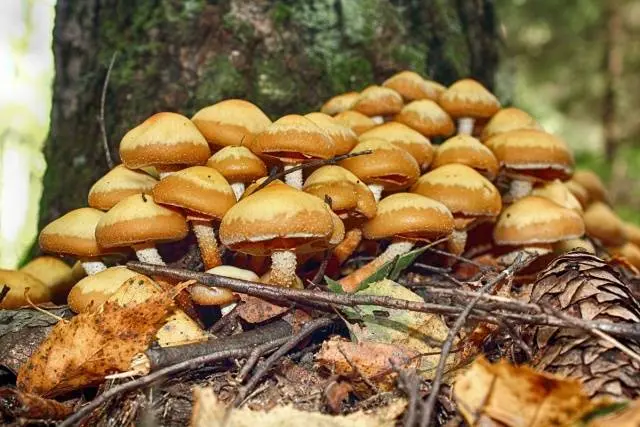
Cooking application
Collected mushrooms are frozen for the winter raw or after heat treatment. They are added to first courses, side dishes and snacks. Honey mushrooms can be pickled, salted, sour, dried, fried and stewed.
Dangerous twins of summer honey agaric with name and photo
Edible mushrooms have many counterparts. Outwardly, these mushrooms are very similar. Upon closer inspection, you can distinguish summer mushrooms from their dangerous counterparts.
How to distinguish a bordered galerina from a summer honey agaric
Bordered Galerina is a deadly poisonous mushroom. Its shape and color are identical to edible mushrooms. Galerina occurs from early August to late autumn.
Features of the bordered gallery:
- completely absent scales on the cap and leg (edible mushrooms must have them);
- a hemispherical hat (in young mushrooms it is often asymmetric, but as it grows it acquires a more regular shape);
- the uniform reddish color of the cap (the center of the cap is darker in honey mushrooms, there is a yellow ring around it, and a dark border around the edges);
- floury smell of pulp;
- more common in coniferous forests;
- grows singly or in 2-3 pieces.
When ingested, galerin leads to disruption of the liver and can cause death. The most difficult thing is to distinguish between the bordered galerina and the summer mushroom when the mushrooms have outgrown.
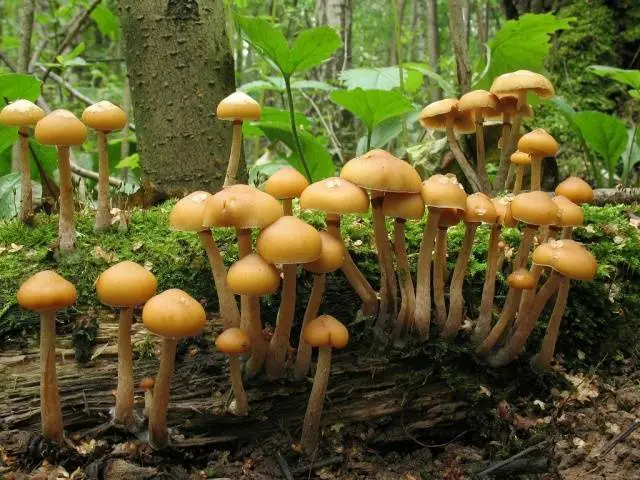
false honeycomb
False mushrooms are a group of mushrooms that mimic edible mushrooms. Twins have lamellar hats 5-7 cm in size and a stalk 10 cm long. False honey mushrooms grow on rotten trees.
Varieties of falcon:
- Grey-yellow. Poisonous false foam of gray or brown color with a yellow tint. The central part of the cap is darker. The plates on the back of the cap are greenish in color.

- Serolamellar. In young specimens, the cap is hemispherical in shape, becoming flattened over time. The color of false summer mushrooms changes from yellowish to brown depending on the level of humidity.

- Brick red. A large false frond with a cap diameter of more than 10 cm. It is reddish in color, with a dark center, the leg is pale yellow.

- Watery. Young mushrooms have a bell-shaped cap that thickens as they grow. The color depends on the level of humidity and varies from cream to bright brown. The leg is pale in color. False honeysuckle grows from June to October.
It is possible to distinguish summer mushrooms from false ones by the presence of a ring on a leg, a dim hat, beige or yellowish plates in edible mushrooms. Poisonous specimens have an unpleasant odor reminiscent of mold or damp earth. Upon contact with water, false honey mushrooms acquire a blue or black color.
Flake coal-loving
Coal-loving flake is a rare mushroom that is edible, but does not have taste and nutritional value.
Scale – a mushroom of medium or large size. In young specimens, the cap is hemispherical, in old specimens it is flat. The fruiting body is always completely covered with scales. Leg 3-6 cm long, hard and fibrous.
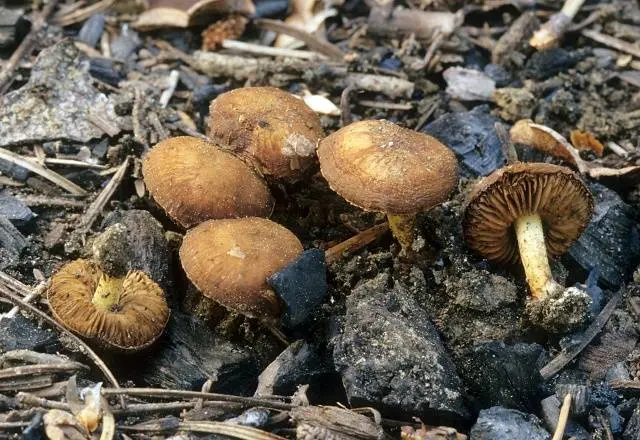
Psatirella
The mushroom is considered conditionally edible. Taste and nutritional value are low. Psatirella has a yellow or brown cap with a tubercle and cracked edges.
Young mushrooms have a bell-shaped top that flattens out over time. The surface of the cap is smooth and dry.
Leg height from 3 to 11 cm, hollow, curved, with powdery coating. The plates are beige, gradually changing color to brown. The flesh is brown, odorless, bitter in taste.
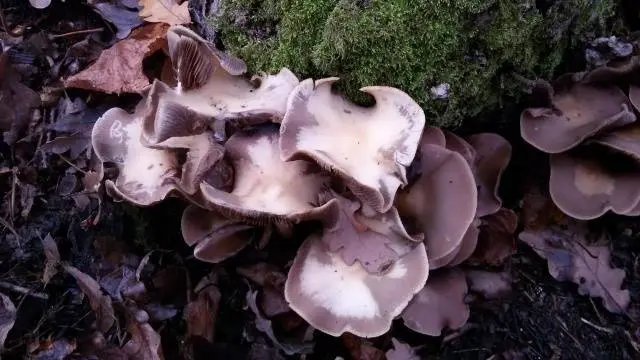
Is it possible to grow summer mushrooms on a personal plot
Honey mushrooms are grown in the backyard, they successfully grow at home on sawdust or seed husks.
Mycelium is obtained independently by grinding mushroom caps. It can be purchased already ready for planting.
In April or May, the mycelium is populated in growing stumps or cut down trees, after which it is regularly watered. Maintaining a constant temperature (from +15 to +20 ° C) helps to stimulate the growth of fungi. Logs are kept in the basement or cellar.
When the mycelium begins to grow, the wood is transferred to the site and partially buried in the ground. A greenhouse or any darkened piece of land is suitable for growing mushrooms.
In the first year, the mycelium gives a low yield. Fruiting begins in June and depends on the quality of wood and climatic conditions. Under favorable circumstances, next year the yield increases by 4 times. Mushrooms are harvested from one mycelium for 4-6 years.
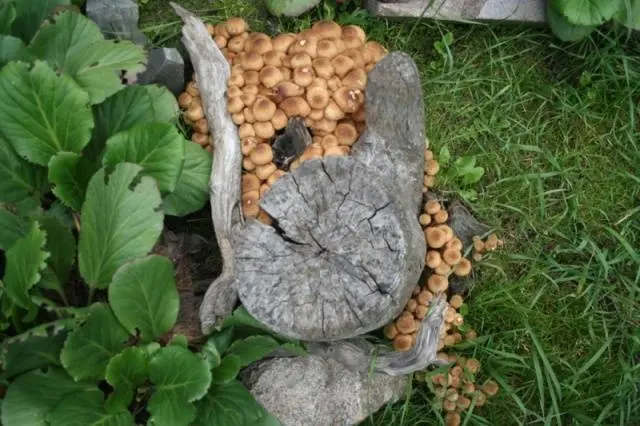
Conclusion
Summer mushroom is a tasty and healthy mushroom. When collecting mushrooms, it is important to distinguish them from dangerous counterparts. Collected mushrooms are cleaned and subjected to heat treatment.











